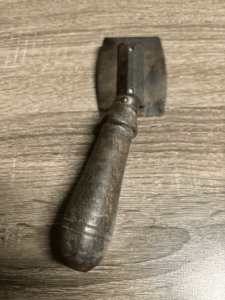The veneer saw, an indispensable tool in the woodworking arsenal, has a rich history that dates back to the 19th century, a time marked by remarkable advancements in woodworking techniques. This period was characterized by an increased demand for finely crafted furniture and the integration of intricate inlays that enhanced the aesthetic appeal and perceived value of wooden items. Here’s a deeper look into the historical significance, usage, and enduring legacy of the veneer saw.
Historical Significance of the Veneer Saw

The inception of the veneer saw in the 19th century revolutionized the woodworking industry. Designed to cut thin slices of wood, known as veneers, from larger pieces of timber, these saws enabled craftsmen to cover the surfaces of furniture with attractive layers of wood. These veneers not only allowed for the creation of decorative patterns but also made it possible to give less expensive woods a luxurious appearance. The earliest models of the veneer saw were crafted from high-quality steel and often featured ornate handles, reflecting the tool’s importance in skilled craftsmanship.
Utilization in Woodworking
Veneer saws are distinguished by their thin, fine-toothed blades, which are crucial for making precise cuts in veneer materials. The unique design of the saw, including a narrow blade set at a slight angle, ensures a clean slice through the wood, minimizing any potential splintering. This precision made the veneer saw an essential tool for woodworkers who needed to trim and fit veneers onto furniture, cabinetry, and decorative wood panels. The meticulous nature of this task required not only a delicate touch but also a steady hand, making the veneer saw particularly suited for high-quality, detailed woodworking projects.
The Legacy of Craftsmanship
Despite the advent of modern power tools that facilitate veneer cutting, the vintage veneer saws hold a special place in the hearts of collectors and woodworking enthusiasts. These tools are not merely instruments of wood manipulation but are revered for their craftsmanship and historical value. They symbolize the artistry and meticulous skill of traditional woodworking practices. Today, vintage veneer saws are often displayed in workshops and museums, serving as a reminder of the elaborate and painstaking processes involved in creating fine furniture and intricate wood designs.
Modern-Day Relevance and Inspiration
The legacy of the vintage veneer saw continues to resonate in the woodworking community. It stands as a testament to the precision and artistry that defined historical woodworking techniques and inspires contemporary craftsmen. In an era dominated by automated tools, there is a growing appreciation for the elegance and traditional craftsmanship of hand tools. The veneer saw, with its rich history and functional design, encourages modern woodworkers to incorporate elements of classical woodworking into their projects, blending the old with the new to create pieces that are both beautiful and structurally sound.
Conclusion: Celebrating Traditional Woodworking Tools
The veneer saw, from its historical roots to its modern-day significance, encapsulates the evolution of woodworking tools and techniques. It serves as a bridge connecting past and present woodworking practices, reminding us of the craftsmanship that goes into each slice of wood. As we continue to advance technologically, there remains a profound respect for the tools like the veneer saw that have shaped the woodworking landscape. By preserving these tools and the skills required to use them, we keep the spirit of traditional craftsmanship alive, ensuring it continues to enrich the woodworking world for generations to come.Embrace the craftsmanship of the past and let it inspire your future projects. Share this piece if you too are fascinated by the blend of history and craftsmanship in woodworking!